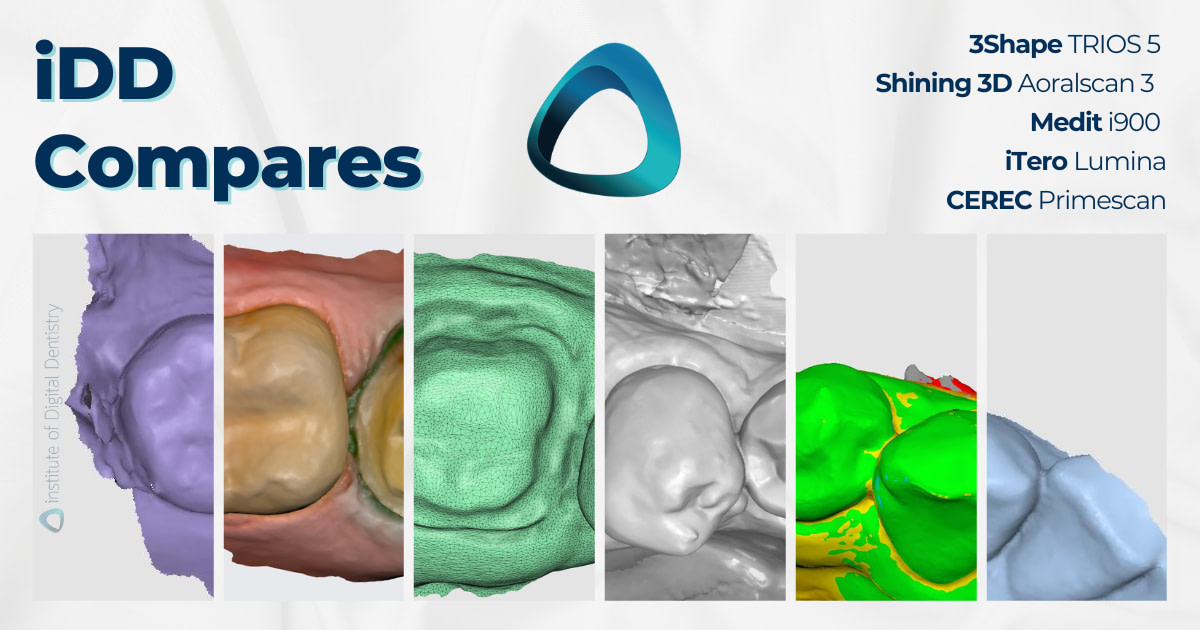2024 has been a busy year!
And we’re only five months in.
So many new products have been released every 3-4 weeks this year. It is certainly an exciting time for the digital dentistry industry.
Two launches, in particular, have captured the intraoral scanner (IOS) world’s attention - iTero’s Lumina, the latest IOS by Align since their Element 5D, and Medit’s i900, which is their most premium scanner and said to be one of the lightest IOS on the market.
So why not put these IOS to the test and see how well they scan compared to some of the most popular and commonly used IOS in the market right now?
At the Institute of Digital Dentistry, we’re very lucky to have tested all our intraoral scanners on real cases and actual patients within a clinical environment.
By doing so, we can provide an honest and unbiased review when comparing the performance of each intraoral scanner.
Dr Ahmad Al-Hassiny scanned his patient, the same 36 crown prep, with five different scanners on the same day:

From left to right: 3Shape TRIOS 5, SHINING 3D Aoralscan 3, Medit i900, iTero Lumina, and CEREC Primescan.
Below, you can see the results of the individual scans - pictures of the color scan, exported STLs, tessellated mesh, and a close-up of the prep margin.
Download all the scan images at 5x higher resolution?
Individual Scans in their Native Software
Every intraoral scanner is equipped with its own sophisticated scanning software.
Most scanners can automatically remove scan artifacts such as movable soft tissue, cheeks, and tongue through AI, with some performing better than others.

We can preview how these scanners capture color (called texture) using the scanner’s native software.
Every scanner captures color slightly differently depending on how accurately the scanner can pick up the light bouncing back off the prep and adjacent teeth. It also depends on the algorithms built in to convert this data into color on the software.
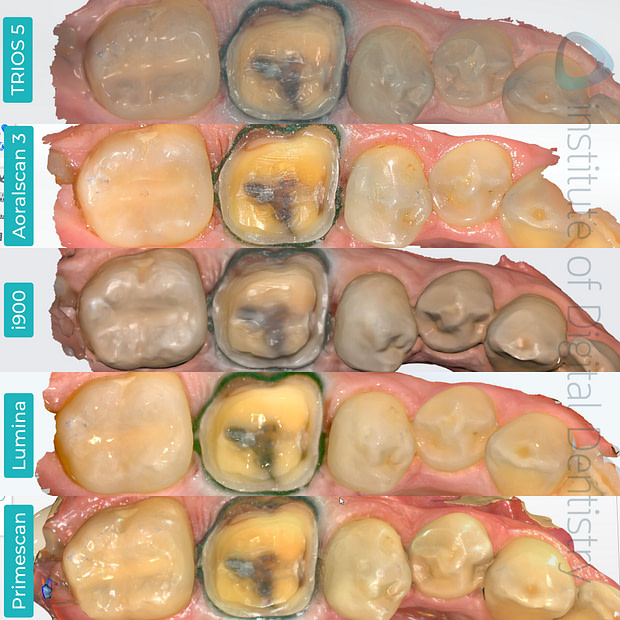
The processed, colored scans of the same tooth preparation were captured using five different scanners, as previewed in their native software.
As you can see, 3Shape’s TRIOS 5 scan is less bright (less value) than the others.
Both 3Shape TRIOS 5 and Medit i900 are also less warm in color (hue) in contrast to the richer, warmer scans of SHINING 3D Aoralscan 3, iTero Lumina, and CEREC Primescan.
SHINING 3D Aoralscan 3 appears to be the most photo-realistic scan in comparison.
This type of scan texture is characteristic of many Chinese intraoral scanners and is purely personal preference - if you prefer realistic scans with image-like capture of the intraoral structures or a more illustrative representation.
Monochromatic scans can also be taken and previewed in their native software. By looking at scans in monochrome, scans provide a better view of the prep's quality and are even recommended to check for any scan issues that are not as obvious when viewed in color.
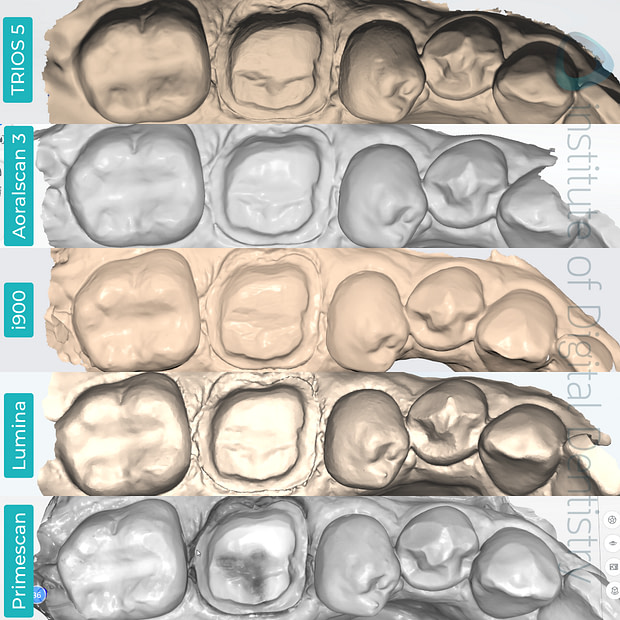
The processed monochromatic scans of the same tooth preparation were captured using five different scanners, as previewed in their native software.
Unlike the native color rendering, only two notable differences exist between the five scans.
iTero Lumina has a bright, almost overexposed, monochromatic scan. With the edges looking a lot more sharper almost jagged.
CEREC Primescan possesses slightly more definition with the occlusal morphology and the mesial and distal margin lines.
Download all the scan images at 5x higher resolution?
Exported Scans in Third-Party Software
All intraoral scanners have an open architecture that allows scans to be exported and sent to labs.
These scans are usually exported in three various formats - STL, PLY or OBJ files.
STL files are exported as monochromatic scans, whereas OBJ and PLY files store color (texture).
Not all intraoral scanners can export OBJ and PLY files, whereas STL files are widely used as a default setting in the entire industry.
This particular set of scanners is capable of exporting scans in these formats:
SHINING 3D Aoralscan 3 and Medit i900 - STL, PLY and OBJ
3Shape TRIOS 5 and iTero Lumina - STL and PLY
CEREC Primescan - STL only
STL File Sizes Compared
3Shape TRIOS 5
SHINING 3D Aoralscan 3
Medit i900
iTero Lumina
CEREC Primescan
PLY File Sizes Compared
3Shape TRIOS 5
SHINING 3D Aoralscan 3
Medit i900
iTero Lumina
CEREC Primescan
OBJ File Sizes Compared
3Shape TRIOS 5
SHINING 3D Aoralscan 3
Medit i900
iTero Lumina
CEREC Primescan
Based on the table above, we can see that all other scanners have a similarly sized file, except CEREC Primescan (exported on their ‘high resolution’ option), which is 3x larger in file size.
The higher resolution or encoding of larger-sized objects requires more facets (triangles within the tessellation) to cover the 2D surface of the scan.
Labs often use third-party CAD software like exocad. In this case, we used Medit Design to preview the received STL, PLY, or OBJ files and to take a closer look at the amount and detail of data captured within each scan.
By exporting the scans outside their native software, we can view the scans objectively without the customized color and optimized surface rendering of the individual scanner’s built-in software.
When we observe the close-up of the preps and their tessellated mesh, Primescan seems to have the densest mesh, closely followed by Aoralscan 3 and then i900, TRIOS 5, and Lumina.
There are yet to be any studies investigating the clinical significance of mesh density. It is important to note that a denser mesh does not necessarily indicate a ‘better scan.’
Download all the scan images at 5x higher resolution?
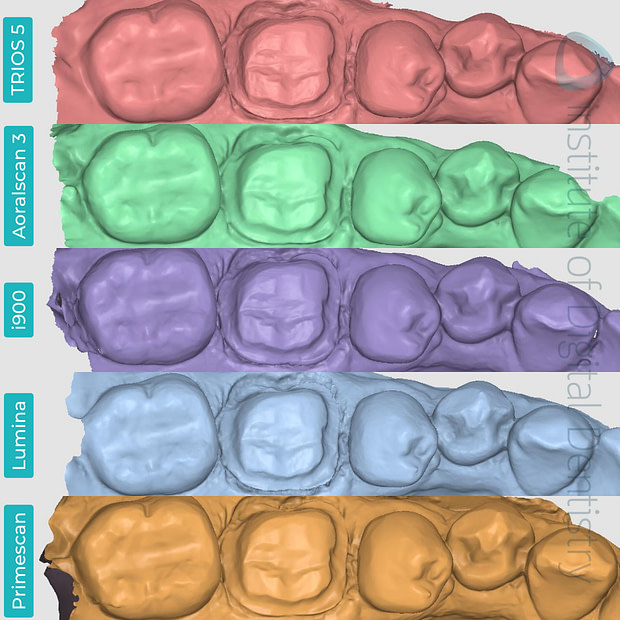
All scans were exported in an STL format and previewed in the Medit Design app.
Prep margins can also be reviewed using this software.
When comparing intraoral scanners, we usually compare them to the CEREC Primescan, which is commonly regarded as one of the best intraoral scanners in terms of accuracy. It is also a scanner I use every day in the office to fabricate same-day crowns that fit perfectly.



In that light, when we look at the prep margin lines captured by each IOS, the iTero Lumina also looks quite sharp. The buccal and lingual margin lines are very defined. Keep in mind that the iTero Lumina is not currently approved for restorative use by the company, infact you cannot even choose this in the lab form. This will be released later this year.
Overall, however, all scanners did a very good job, especially on the lingual margin which was supragingival and sharper. The buccal margin which was closer to the retraction cord, seemed to look less sharp but no doubt acceptable in all of the other scanners.
Just for interest, iTero Lumina’s scanning technology can carry out a maximum capture distance of 25mm, whereas CEREC Primescan can measure depth up to 20 mm. The Medit i900 is said to be around 30mm.
When looking for deviations, we allocated Primescan as our point of reference to compare all other scanners. Deviation can be seen below, and the scale is 50 microns.
Download all the scan images at 5x higher resolution?
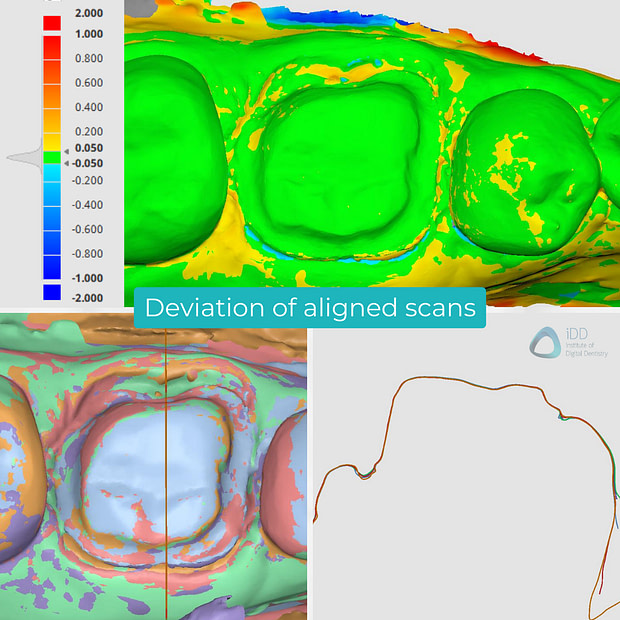
Deviation map of the scans as compared to CEREC’s scan and sectional view. There seems to be very little deviation around the prep area.
Based on the colored deviation key, we can see that the scan meshes are within 50 microns compared to the scan taken with CEREC Primescan. Within the same Display mode, we can also view the aligned scans in a sectional view in which we can see minimal differences between the scans.
Bottom line, all scanners work.
Conclusion
It is important to remember that the precision in capturing the details of the restoration preparation may vary slightly based on the combination of the clinician's scanning technique and the specific scanner used.
This variation can influence the final outcome of the dental lab technicians' restoration margin.
How did the newest flagship IOS compare to the top IOS on the market?
Did they perform as well as you thought they would?
Overall, the new iTero Lumina and Medit i900 look promising and add to the long list of capable intraoral scanners on the market right now.
Let us know your thoughts.
Leave a comment below about which IOS you’d like us to compare next.

